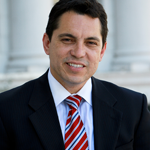• Data Presented in Texas House Public Education Committee Hearing on CSHB 1759 • IDRA Newsletter • May 2015 •
 David Hinojosa, J.D., IDRA national policy director, presented expert testimony in April based on IDRA’s analysis of Committee Substitute House Bill 1759, put forth by state Rep. Jimmie Don Aycock, who chairs the House Public Education committee, in an attempt to improve the way Texas funds it public schools.
David Hinojosa, J.D., IDRA national policy director, presented expert testimony in April based on IDRA’s analysis of Committee Substitute House Bill 1759, put forth by state Rep. Jimmie Don Aycock, who chairs the House Public Education committee, in an attempt to improve the way Texas funds it public schools.
“We appreciate Chairman Aycock for taking the leadership role in presenting a school finance plan this session that seeks to put more resources into public education,” summarized Mr. Hinojosa. “Unfortunately, the plan fails to continue that trek toward greater equity and instead puts significantly greater resources, on average, in the wealthiest districts.”
IDRA’s analyses show that the measure fell short by:
- Increasing the inequitable funding between students in the poorest districts and those in the wealthiest districts;
- Failing to address the inadequate funding and opportunities for economically disadvantaged and English language learner students; and
- Failing to provide sufficient revenue to ease the tax burdens of several property-poor school districts taxing at or near the cap of $1.17.
In May, Representative Aycock withdrew his school finance plan to avoid the hours of debate that were expected as a result of various controversial features it contained. His proposal was one of two school finance proposals offered during this session following the Texas District Court ruling that the Texas school finance system violates the Texas Constitution, finding that the current funding system is “constitutionally inadequate, unsuitable and financially inefficient.”
In addition to Aycock’s proposal, Representatives Armando Walle, Mary Gonzalez and Diego Bernal have sponsored House Bill 3671, which would provide a far more equitable and adequate education for millions of Texas children than ever before. It would do so by:
- Increasing the basic allotment to amounts that more closely reflect the actual funding levels needed to provide a quality education in Texas;
- Increasing funding weights for low-income and English language learner students (for the first time in 30 years);
- Calling for a new cost study to guide future funding efforts particularly as they affect funding equity;
- Increasing efficiency in state funding by eliminating excessive enrichment reserved only for super-wealthy districts without creating an undue burden on the school children in those districts; and
- Increasing transparency in how state funding is used in schools.

IDRA research has found that under the current funding system, there is $1,098 gap in per student spending between the 100 poorest and 100 wealthiest schools in the state. (see infographic)
This means that the richest school districts have about $27,450 more to spend per classroom to recruit and retain the most qualified teachers and maintain lower student to teacher ratios. They can offer advanced placement and dual credit courses and provide the counseling and academic supports to focus on college readiness. And by covering the cost of transportation and arts and music programs, they can engage students in all kinds of ways.
IDRA has provided expert testimony and analyses in every Texas school finance case dating back to the first Edgewood case in the 1980s through the more current Edgewood VI. In the latest case, Dr. Albert Cortez, IDRA director of policy, testified: “Low-income and minority students in Texas are more likely to be in under-resourced schools with limited access to quality teaching and curriculum. In Texas, the quality of schooling still seems to be markedly affected by the neighborhood in which you happen to reside.”
Research released at the IDRA José A. Cárdenas School Finance Fellows Program Symposium in February stressed the specific need for Texas to secure educational equity and excellence for English language learners in Texas secondary schools.
In analyzing any plan, the following minimal features must be assured:
- Fair funding now – There is not a need for complete restructuring of the school funding system. But Texas school funding must be equitable, provide for equal return for equal tax effort, and provide equitable access to excellent education (high quality curricula, teaching, support services, and facilities) for all students in all school districts.
- Features that maintain inequity and that have been hidden within the state funding system for decades need to be eliminated immediately – no more phasing out.
- Special population funding increases must be implemented now. After decades of neglect, Texas needs to increase funding for compensatory education and ELL weights to 40 percent, as supported by the research literature.
- Public funding must be reserved for public schools. Diverting public money away from public schools would do nothing to address the current crisis and would create dual school systems: one separate for the few and one under-funded for the many.
- Facilities funding priority should be given to public schools.
Dr. María “Cuca” Robledo Montecel, IDRA President, stated: “It is imperative that we have excellent and equitable education for all Texas school children. We call on policymakers to have the courage to do what it takes to invest in our state’s children. The future of us all depends on it.”
Comments and questions may be directed to IDRA at comment@idra.org.
[©2015, IDRA. This article originally appeared in the May 2015 IDRA Newsletter by the Intercultural Development Research Association. Permission to reproduce this article is granted provided the article is reprinted in its entirety and proper credit is given to IDRA and the author.]


